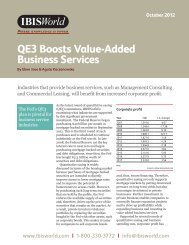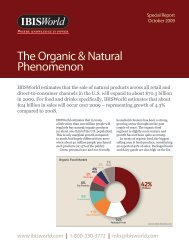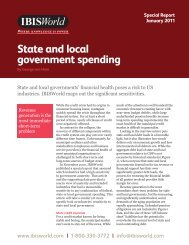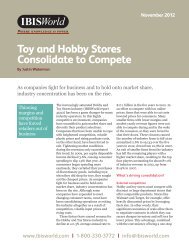The Smoothie Supply Chain - IBISWorld
The Smoothie Supply Chain - IBISWorld
The Smoothie Supply Chain - IBISWorld
You also want an ePaper? Increase the reach of your titles
YUMPU automatically turns print PDFs into web optimized ePapers that Google loves.
WWW.IBISWORLD.COM Special Report Month 2012 1<br />
Follow on head on Master page A<br />
Special Report<br />
August 2012<br />
<strong>The</strong> <strong>Smoothie</strong> <strong>Supply</strong> <strong>Chain</strong><br />
By Agata Kaczanowska<br />
<strong>IBISWorld</strong> explores how changes in the supply chain affect growth for<br />
smoothie and juice bars<br />
Rising incomes<br />
will push up<br />
revenue, but<br />
competition will<br />
pressure growth<br />
Consumers are expected to loosen their<br />
purse strings in the coming years,<br />
bolstering demand for the Juice and<br />
<strong>Smoothie</strong> Bars industry. Rising<br />
employment will increase disposable<br />
income, and Americans will be better<br />
able to afford juice and smoothies from<br />
industry establishments. Consumers will<br />
also have limited time to make their own,<br />
leading them to buy more products on<br />
the go. As a result, Juice and <strong>Smoothie</strong><br />
Bar industry revenue is projected to rise<br />
at a 2.2% annualized rate to $2.0 billion<br />
during five years to 2017, including a<br />
1.6% increase in 2013.<br />
Competition souring growth<br />
External competition from other<br />
industries is forecast to restrain revenue<br />
growth in the next five years. <strong>The</strong> Fast<br />
Food Restaurants industry (<strong>IBISWorld</strong><br />
report 72221a), which includes<br />
companies like McDonald’s, is expected<br />
to continue marketing beverages like<br />
smoothies and juices, which draws<br />
demand away from industry<br />
enterprises. Other major competitors<br />
include the Coffee and Snack Shops<br />
(72221b), Vending Machines Operators<br />
(45421), and Gym, Health and Fitness<br />
clubs (71394) industries. Bottled<br />
beverage manufacturers are also<br />
increasingly competing with juice and<br />
Competitionbyindustryrevenue<br />
Industry<br />
Revenue<br />
($thousands)<br />
Fast Food Restaurants 169,709.9<br />
Coffee & Snack Shops 27,843.8<br />
Juice Production 27,282.7<br />
Gym, Health & Fitness Clubs 25,269.1<br />
Vending Machine Operators 7,335.1<br />
Meal Replacement<br />
Product Manufacturing<br />
2,298.2<br />
Juice & <strong>Smoothie</strong> Bars 1,806.2<br />
<strong>Smoothie</strong> Production RTD 632.5<br />
SOURCE: WWW.IBISWORLD.COM<br />
smoothie bars, and the most direct<br />
competitors include the ready-to-drink<br />
<strong>Smoothie</strong> Production (OD4300), Meal<br />
Replacement Product Manufacturing<br />
(OD4285) and Juice Production<br />
(31211c) industries. <strong>The</strong> combined total<br />
revenue of these industries is projected<br />
to grow from $26.2 billion in 2012 to<br />
$29.0 billion in 2017, representing a<br />
2.1% annualized increase over the five<br />
years. This growth rate includes a 2.2%<br />
initial increase in 2013.<br />
To better compete with the increasing<br />
number of alternative juice and smoothie<br />
retailers, industry operators are altering<br />
their strategies. For example, major<br />
company Jamba Inc. now serves<br />
www.ibisworld.com | 1-800-330-3772 | info@ibisworld.com
WWW.IBISWORLD.COM Special Report August 2012 2<br />
<strong>The</strong> <strong>Smoothie</strong> <strong>Supply</strong> <strong>Chain</strong><br />
breakfast items. By diversifying its menu,<br />
the company hopes to attract customers<br />
throughout the day. Companies are also<br />
offering organic products, as well as<br />
drinks that appeal to consumers with diet<br />
restrictions, such as gluten-free or<br />
low-sugar beverages.<br />
A sweet decline<br />
<strong>The</strong> healthy eating index is projected to<br />
decline in the next five years, despite<br />
widely reported obesity rates and other<br />
nutrition-related diseases. <strong>IBISWorld</strong><br />
forecasts that the healthy eating index<br />
will drop at a 0.2% annualized rate in the<br />
five years to 2017. As it turns out,<br />
however, a dip in the healthy eating<br />
index may correspond to increasing<br />
smoothie consumption due their high<br />
sugar content. In fact, the Centers for<br />
Disease Control and Prevention (CDC), a<br />
government health organization,<br />
published specific instructions in 2010<br />
for consumers to follow at smoothie<br />
establishments, entitled “At the<br />
<strong>Smoothie</strong> Stand.”<br />
This advice from the CDC comes at a<br />
time when sugar consumption is on the<br />
decline in the United States. <strong>The</strong> percent<br />
of daily calories derived from added<br />
sugars declined from 1999 to 2008,<br />
according to a study published in the<br />
American Journal of Clinical Nutrition in<br />
2011, as cited on the CDC website.<br />
According to data from the US<br />
Department of Agriculture, per capita<br />
sugar and sweetener consumption is<br />
forecast to continue declining to 132.6<br />
pounds per person in 2012, from about<br />
135.5 pounds per person in 2007.<br />
Despite the CDC’s advice for<br />
consumers to decrease sugar<br />
consumption, the federal government<br />
supports the Sugar Processing industry<br />
(<strong>IBISWorld</strong> report 31131) through<br />
nonrecourse loans and marketing<br />
allotments as part of several programs,<br />
including the 2008 Farm Act, the<br />
Feedstock Flexibility Program and the<br />
Tariff Rate Quota system. <strong>IBISWorld</strong><br />
estimates that Sugar Processing industry<br />
revenue will increase 1.1% annually on<br />
average, from $9.0 billion in 2012 to $9.5<br />
billion in 2017. However, the United<br />
States has agreed to increase quotas for<br />
several countries in Latin America over<br />
next 15 years, allowing larger volumes of<br />
low-price imports to enter the United<br />
States at a low-tier tariff rate. As a result,<br />
a larger part of domestic demand will be<br />
met from increased imports, pushing<br />
down US sugar prices. This is expected to<br />
Upstreamindustryrevenue(2012)<br />
Industry<br />
Revenue<br />
($thousands)<br />
Plastic & Resin Manufacturing (polyethylene) 37,844.1<br />
Dairy Product Production (milk and milk-based products) 37,799.3<br />
Cardboard Box & Container Manufacturing (cardboard boxes) 36,899.9<br />
Vitamin & Supplement Manufacturing (all products) 29,245.8<br />
Vegetable Farming (tomatoes, greenhouse crops and other crops) 18,013.1<br />
Fruit & Nut Farming (berries, apples, grapes and other crops) 14,424.6<br />
Sugar Processing (refined sugar) 6,650.2<br />
Wood Pallets & Skids Production (all products) 4,741.9<br />
Polystyrene Foam Manufacturing (consumer and institutional products) 3,401.6<br />
Orange & Citrus Groves (all products) 2,917.9<br />
Soy & Almond Milk Production (soy, almond, coconut and other crops) 1,465.0<br />
SOURCE: WWW.IBISWORLD.COM
WWW.IBISWORLD.COM Special Report August 2012 3<br />
<strong>The</strong> <strong>Smoothie</strong> <strong>Supply</strong> <strong>Chain</strong><br />
benefit juice and smoothie bars, which<br />
use sugar in their products.<br />
Juice and smoothie operators’ bottom<br />
lines are expected to benefit from lower<br />
input costs and higher demand for<br />
industry products. Higher demand will<br />
enable stores to boost prices, despite<br />
competition. Consequently, profit, as<br />
measured by earnings before interest<br />
and taxes, is estimated to increase to<br />
3.9% of 2017 revenue, from about 3.0%<br />
of 2012 revenue.<br />
Suppliers smoothing the way<br />
Nonetheless, it takes much more than<br />
sugar to make a smoothie. Juice and<br />
smoothie bars use inputs from 11<br />
upstream industries. <strong>The</strong> largest<br />
suppliers manufacture polyethylene, milk<br />
and milk-based products, cardboard<br />
boxes, vitamins and supplements,<br />
vegetables, and fruits and nuts.<br />
Regulations for juice and smoothie<br />
bars influence these upstream<br />
manufacturers. For example, the Plastic<br />
and Resin Manufacturing industry<br />
(<strong>IBISWorld</strong> report 32521) produces<br />
polystyrene (<strong>IBISWorld</strong> classifies<br />
polystyrene under the industry’s<br />
polyethylene segment). Most juice and<br />
smoothie bar franchises, including major<br />
companies Jamba Juice and <strong>Smoothie</strong><br />
King, use smoothie cups made of this<br />
material. <strong>The</strong> cups help insulate the<br />
beverage to keep it cool, and are sturdy<br />
enough to hold thick drinks. Some<br />
environmental laws have banned the use<br />
of polystyrene cups. Such bans force<br />
companies to find alternative packaging,<br />
which can increase costs or lower<br />
customer satisfaction. Such regulation<br />
also hampers revenue growth for the<br />
Plastic and Resin Manufacturing<br />
industry, which is anticipated to rise<br />
3.8% in 2013. During the next five years,<br />
the plastic industry’s revenue is expected<br />
to rise 8.1% annually on average, from<br />
$37.8 billion in 2012 to $44.2 billion in<br />
2017. Stronger industrial production and<br />
construction activity, which are not<br />
<strong>Supply</strong> Industries<br />
Juice & <strong>Smoothie</strong> Bars<br />
End User Markets<br />
Vitamin & Supplement<br />
Manufacturing<br />
Paper Bag & Diposable<br />
Plastic Product<br />
Wholesaling<br />
Frozen Food<br />
Wholesaling<br />
Fruit & Vegetable<br />
Wholesaling<br />
Related Industries<br />
<strong>Chain</strong> Restaurants Coffee & Snack Shops<br />
Fast Food Restaurants<br />
Households with<br />
Incomes More Than<br />
$75,000<br />
Households with<br />
Incomes Between<br />
$50,000 and $75,000<br />
Households with<br />
Incomes Less Than<br />
$50,000
WWW.IBISWORLD.COM Special Report August 2012 4<br />
<strong>The</strong> <strong>Smoothie</strong> <strong>Supply</strong> <strong>Chain</strong><br />
About <strong>IBISWorld</strong> Inc.<br />
Recognized as the nation’s<br />
most trusted independent<br />
source of industry and<br />
market research, <strong>IBISWorld</strong><br />
offers a comprehensive<br />
database of unique<br />
information and analysis on<br />
every US industry. With an<br />
extensive online portfolio,<br />
valued for its depth and<br />
scope, the company equips<br />
clients with the insight<br />
necessary to make better<br />
business decisions.<br />
Headquartered in<br />
Los Angeles, <strong>IBISWorld</strong><br />
serves a range of business,<br />
professional service and<br />
government organizations<br />
through more than<br />
10 locations worldwide.<br />
For more information, visit<br />
www.ibisworld.com or call<br />
1-800-330-3772.<br />
deterred by these regulations, will<br />
underpin sustained growth for this<br />
industry. For more information on<br />
individual industries within this supply<br />
chain, please reference their respective<br />
<strong>IBISWorld</strong> reports.<br />
Conclusion<br />
Analysis within <strong>IBISWorld</strong> reports<br />
enables clients to fully understand the<br />
complex way in which industries are<br />
interrelated. Charts, including the Full<br />
Context Diagram that is on each report’s<br />
website, help clients see the economic<br />
factors and related industries that link<br />
directly to each report. For example,<br />
please refer to the Full Context Diagram<br />
of the Juice and <strong>Smoothie</strong> Bars industry<br />
(<strong>IBISWorld</strong> report OD4325). Many of the<br />
supply industries reported are<br />
distributors (also called wholesalers) that<br />
function as a go-between the<br />
manufacturers outlined in this report and<br />
the Juice and <strong>Smoothie</strong> Bars industry<br />
– an integral part of the supply chain<br />
about which <strong>IBISWorld</strong> reports.<br />
Contact:<br />
Savannah Haspel<br />
VP, Public Relations<br />
<strong>IBISWorld</strong><br />
Phone: 1-310-866-5044<br />
savannahh@ibisworld.com<br />
www.ibisworld.com
www.ibisworld.com | 1-800-330-3772 | info@ibisworld.com<br />
At <strong>IBISWorld</strong> we know that industry intelligence<br />
is more than assembling facts. It is combining<br />
data with analysis to answer the questions that<br />
successful businesses ask.<br />
Identify high growth, emerging and shrinking markets<br />
Arm yourself with the latest industry intelligence<br />
Assess competitive threats from existing and new entrants<br />
Benchmark your performance against the competition<br />
Make speedy market-ready, profit-maximizing decisions<br />
Who is <strong>IBISWorld</strong>?<br />
We are strategists, analysts, researchers and marketers. We provide<br />
answers to information-hungry, time-poor businesses. Our goal is to give<br />
you the real-world answers that matter to your business in our 700 US<br />
industry reports. When tough strategic, budget, sales and marketing<br />
decisions need to be made, our suite of Industry and Risk intelligence<br />
products give you deeply researched answers quickly.<br />
<strong>IBISWorld</strong> Membership<br />
<strong>IBISWorld</strong> offers tailored membership packages to meet your needs.<br />
Join and become an industry expert!<br />
Disclaimer<br />
This product has been supplied by <strong>IBISWorld</strong> Inc. (‘<strong>IBISWorld</strong>’) solely for use<br />
by its authorized licenses strictly in accordance with their license agreements<br />
with <strong>IBISWorld</strong>. <strong>IBISWorld</strong> makes no representation to any other person<br />
with regard to the completeness or accuracy of the data or information<br />
contained herein, and it accepts no responsibility and disclaims all liability<br />
(save for liability which cannot be lawfully disclaimed) for loss or damage<br />
whatsoever suffered or incurred by any other person resulting from the use<br />
of, or reliance upon, the data or information contained herein. Copyright in<br />
this publication is owned by <strong>IBISWorld</strong> Inc. <strong>The</strong> publication is sold on the<br />
basis that the purchaser agrees not to copy the material contained within it<br />
for other than the purchasers own purposes. In the event that the purchaser<br />
uses or quotes from the material in this publication – in papers, reports, or<br />
opinions prepared for any other person – it is agreed that it will be sourced<br />
to: <strong>IBISWorld</strong> Inc.<br />
© Copyright 2012. <strong>IBISWorld</strong> Inc.














